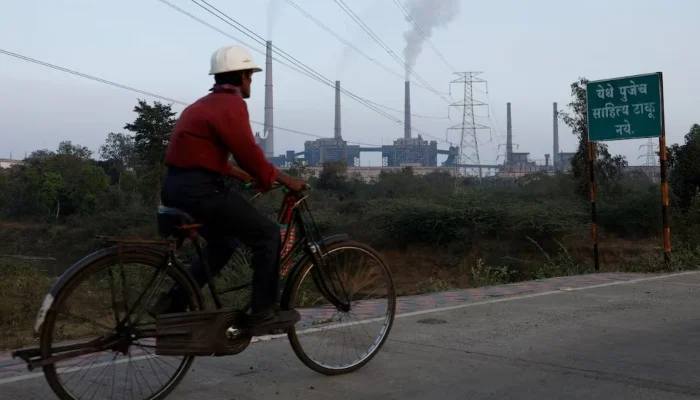For residents of Solapur, a hot and arid district in western India, April marks the onset of the most challenging months. As temperatures climb, water resources diminish, leading to waits of a week or more for tap water during the peak summer. A mere decade ago, water flowed every other day, as confirmed by local government and residents of Solapur, situated approximately 400km inland from Mumbai.
However, in 2017, a 1,320-megawatt coal-fired power plant operated by state-controlled NTPC commenced operations. This facility provided much-needed energy to the district but simultaneously began competing with residents and businesses for water from the local reservoir. Solapur exemplifies India’s predicament: it is home to 17% of the global population but possesses only 4% of the world’s water resources. The planet’s most populous nation plans to invest nearly $80 billion in water-intensive coal plants by 2031 to fuel expanding industries like data center operations.
A non-public power ministry document, reviewed by Reuters and intended for official progress tracking, indicates that the vast majority of these new projects are planned for India’s driest areas. Many of the 20 individuals interviewed by Reuters for this story, including power company executives, energy officials, and industry analysts, suggested that this thermal expansion would likely lead to future conflicts between industry and residents over scarce water resources. Thirty-seven of the 44 new projects listed in the undated power ministry shortlist for future operations are located in government-classified water-scarce or water-stressed regions. NTPC, which claims to source 98.5% of its water from water-stressed areas, is involved in nine of these projects.
In response to Reuters’ inquiries, NTPC stated that it is “continuously striving towards conservation of water with best of our efforts in Solapur,” including methods like treating and reusing water. It did not address questions regarding potential expansion plans. India’s power ministry has previously informed lawmakers in parliament, most recently in 2017, that the siting of coal-fired power plants is influenced by factors such as land and water access, with state governments responsible for water allocation.
According to two federal groundwater board officials and two water researchers, access to land is the primary consideration. Rudrodip Majumdar, an energy and environment professor at the National Institute of Advanced Studies in Bengaluru, explained that India’s intricate and often obscure land laws have caused multi-year delays for numerous commercial and infrastructure projects. Consequently, power operators, under pressure to meet burgeoning demand, select areas where they anticipate minimal resistance, even if water sources are distant.
The federal power ministry, along with energy and water authorities in Maharashtra state (where Solapur is located), did not respond to queries. Delhi had attempted to reduce its reliance on coal but reversed course after the COVID-19 pandemic. While it has invested heavily in renewable energy sources like solar and hydro, thirsty thermal power is expected to remain dominant for decades to come.
Ram Vinay Shahi, India’s former top energy bureaucrat, highlighted the strategic importance of readily available power for India, whose per-capita power consumption is significantly lower than that of its regional rival, China. “The only energy resource we have in the country is coal,” he stated. “Between water and coal, preference is given to coal.”
‘Nothing’ in Solapur? Water Woes Continue
Solapur resident Rajani Thoke meticulously plans her life around water availability during summer. On days with supply, “I do not focus on anything other than storing water, washing clothes and such work,” said the mother of two, who strictly monitors her family’s water consumption.
Sushilkumar Shinde, the federal power minister who approved the Solapur plant in 2008 when the area was already categorized as “water scarce,” informed Reuters that he assisted NTPC in procuring land by negotiating payments to locals. A member of the opposition Congress party who won re-election to Solapur’s parliamentary seat a year after the plant’s approval, Shinde defended the operation based on NTPC’s substantial investment. The $1.34 billion plant created thousands of jobs during its construction and now provides part-time employment to approximately 2,500 locals.
“I made sure farmers got good money for the land NTPC acquired,” he asserted, adding that mismanagement by local authorities was responsible for water shortages. Solapur municipal official Sachin Ombase acknowledged that water distribution infrastructure had not kept pace with population growth but assured that authorities were working to address the issue. Shinde contended that “there was nothing” in Solapur in 2008 and that residents who received land payments had no reason to oppose the plant.
Researcher Shripad Dharmadhikary, who founded the environmental advocacy group Manthan Adhyayan Kendra, noted that local politicians often support high-profile infrastructure projects to boost their popularity. Any “problems come up much later,” he observed. Even before the Solapur plant began operations, there were indications of future difficulties. The first of its two units was slated to begin generating power by mid-2016, but its launch was delayed by over 12 months due to years of severe water shortages, according to a 2020 regulatory filing.
The absence of nearby water sources meant the station ultimately drew water from a reservoir approximately 120km away. Such distances can significantly increase costs and the risk of water theft, as noted by Dharmadhikary and two plant sources. As of May 2023, the Solapur station ranks among India’s least water-efficient, according to the latest federal records. It also has one of the lowest capacity utilization rates among coal-fired plants, according to data from government think-tank NITI Aayog.
NTPC maintained that its data indicates the Solapur plant’s efficiency ratio aligns with national norms. Indian power stations typically consume twice as much water as their global counterparts, according to the Delhi-based Centre for Science and Environment think-tank. Solapur plant officials informed reporters in March that capacity utilization would improve with increasing demand, suggesting a potential surge in future water consumption.
A forthcoming survey on water use in Solapur, led by state groundwater authorities and reviewed by Reuters, revealed that irrigation demand in the district surpasses supply by a third. Dharmes Waghmore, who owns farmland a few miles from the plant, said that developing it would offer greater financial security than his current casual work. However, he deemed borrowing money to develop the land by drilling a bore well too risky, asking, “What if there’s no water?”
Kuladeep Jangam, a senior local official, admitted that authorities were struggling to attract businesses to Solapur, stating that the lack of “water neutralizes all other pull factors.”
Thirst for Power: Water Shortages Hamper Coal Generation
Since 2014, India has experienced a loss of 60.33 billion units of coal-power generation nationwide – equivalent to 19 days of coal-power supply at June 2025 levels – primarily due to water shortages forcing plants to suspend operations, according to federal data.
Among the facilities that have grappled with shortages is the 2,920MW Chandrapur Super Thermal Power Station, one of India’s largest. Located approximately 500km northeast of Solapur but also in a water-stressed area, the plant frequently shuts down several of its units for months at a time when monsoon rains are below normal, as per NITI Aayog data.
Despite these challenges, the plant is considering adding 800MW of new capacity, according to the power ministry list seen by Reuters and half a dozen sources at Mahagenco, which operates the station. The document indicates that the plant has not yet identified a water source for this expansion, although it has already secured its coal supply. State-owned Mahagenco did not respond to Reuters’ questions.
The plant’s substantial water demand has previously led to tensions with residents of nearby Chandrapur city. Locals protested against the station during a 2017 drought, prompting officials such as local lawmaker Sudhir Mungantiwar to order it to divert water to homes. Mungantiwar, however, supports the plant’s expansion, hoping it will lead to the retirement of water-inefficient older units.
Yet, the station has already delayed a plan to decommission two polluting and water-guzzling power units with a capacity of 420MW by about seven years, citing instructions from the federal government, company sources confirmed. Reuters has previously reported that the Indian government asked power companies not to retire old thermal plants until the end of the decade due to a surge in demand following the pandemic. Chandrapur resident Anjali, who goes by one name, expressed her resignation to obtaining drinking water from a tap installed by the station near one of its gates. “We’re poor, we make do with whatever we can get,” she stated.



